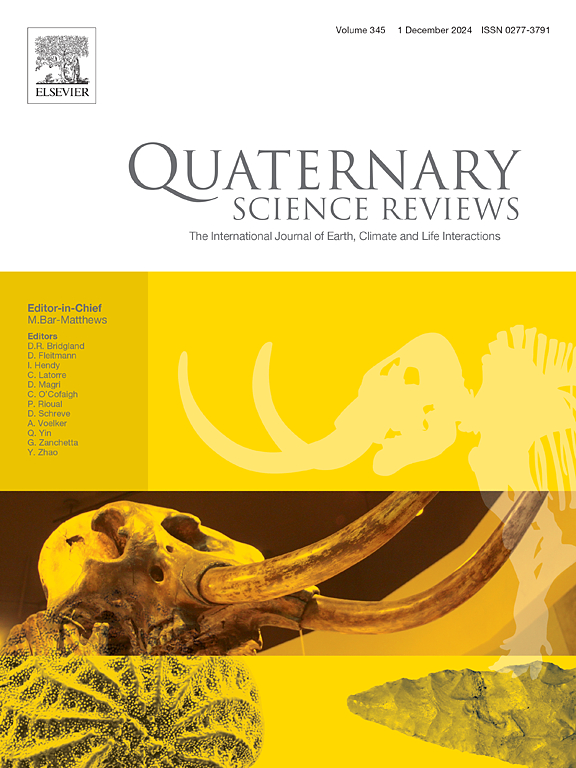Environmental magnetism of late Holocene stalagmites from semi-arid karst in southern Australia
IF 3.2
1区 地球科学
Q1 GEOGRAPHY, PHYSICAL
引用次数: 0
Abstract
Whilst significant progress in speleothem environmental magnetism has been made in recent years, our knowledge of how magnetic proxies respond to Earth-system processes in arid/semi-arid environments is limited. In this study, we investigate calcite stalagmites that form under evaporative conditions near cave entrances in areas that receive low precipitation (∼250 mm/year). Such stalagmites have yet to be explored in environmental magnetism, and are typically avoided in paleoclimatology due to complications in their geochemistry. Proxies based on detrital inclusions, such as speleothem palynology, have, however, proven favorable in these conditions. Here we report the first combination of speleothem magnetism with published pollen and charcoal records from two stalagmites formed over the last ∼2400 years at Webbs Cave, located on the ∼230,000 km2 Nullarbor Plain in southern Australia. Rock magnetic experiments were performed using anhysteretic and isothermal remnant magnetizations, hysteresis loops, and low-temperature remanence measurement to investigate the concentration, phases, and grain size of the magnetic mineral assemblage. Analysis of detrital particles and speleothem porosity was undertaken using x-ray microtomography. The magnetic mineralogy of both stalagmites is typical of stalagmites globally in being dominated by magnetite or maghemite with dominant grain size distributions in the superparamagnetic to single-domain range, which occurs alongside goethite and potentially hematite. Both the low and high coercivity fractions co-vary and are consistent with local soils, furthering the link between stalagmite magnetism and pedogenesis. However, rather than increasing with precipitation, we infer that magnetic particle concentrations can increase during drier climates, based on correlations to the stalagmite pollen records. This likely results from increased detritus in available drip waters, along with increased deposition of localized cave dust during (dry) periods of slow stalagmite growth. While the magnetic particles in near-entrance stalagmites may derive from multiple transport modes, their local soil provenience forms the main control on their magnetic properties.
澳大利亚南部半干旱喀斯特地区晚全新世石笋的环境磁性
虽然近年来在洞穴环境磁学方面取得了重大进展,但我们对干旱/半干旱环境中磁场代理如何响应地球系统过程的了解有限。在这项研究中,我们研究了在低降水(~ 250 mm/年)地区洞穴入口附近蒸发条件下形成的方解石石笋。这类石笋在环境磁学中尚未被探索,由于其地球化学的复杂性,在古气候学中通常被避免。然而,在这些条件下,基于碎屑包裹体的代用物,如洞穴孢粉学,已被证明是有利的。在这里,我们首次将洞穴磁学与已发表的花粉和木炭记录结合起来,这些记录来自韦伯洞穴中形成于过去~ 2400年的两个石笋,位于澳大利亚南部~ 230,000平方公里的纳拉伯平原上。采用非滞后和等温残余磁化、磁滞回线和低温残余测量等方法进行岩石磁性实验,研究磁性矿物组合的浓度、物相和粒度。利用x射线显微断层扫描对碎屑颗粒和岩洞孔隙度进行了分析。两种石笋的磁性矿物学特征均具有全球石笋的典型特征,以磁铁矿或磁铁矿为主,粒度分布在超顺磁至单畴范围内,与针铁矿并列,可能与赤铁矿并列。低矫顽力和高矫顽力组分都是共同变化的,并且与当地土壤一致,进一步加强了石笋磁性与成土作用之间的联系。然而,根据与石笋花粉记录的相关性,我们推断磁颗粒浓度在干燥气候下会增加,而不是随着降水而增加。这可能是由于滴水中碎屑的增加,以及石笋生长缓慢的(干燥)时期局部洞穴尘埃的沉积增加。近入口石笋中的磁性颗粒可能来源于多种输运方式,其局部土壤来源是其磁性的主要控制因素。
本文章由计算机程序翻译,如有差异,请以英文原文为准。
求助全文
约1分钟内获得全文
求助全文
来源期刊

Quaternary Science Reviews
地学-地球科学综合
CiteScore
7.50
自引率
15.00%
发文量
388
审稿时长
3 months
期刊介绍:
Quaternary Science Reviews caters for all aspects of Quaternary science, and includes, for example, geology, geomorphology, geography, archaeology, soil science, palaeobotany, palaeontology, palaeoclimatology and the full range of applicable dating methods. The dividing line between what constitutes the review paper and one which contains new original data is not easy to establish, so QSR also publishes papers with new data especially if these perform a review function. All the Quaternary sciences are changing rapidly and subject to re-evaluation as the pace of discovery quickens; thus the diverse but comprehensive role of Quaternary Science Reviews keeps readers abreast of the wider issues relating to new developments in the field.
 求助内容:
求助内容: 应助结果提醒方式:
应助结果提醒方式:


